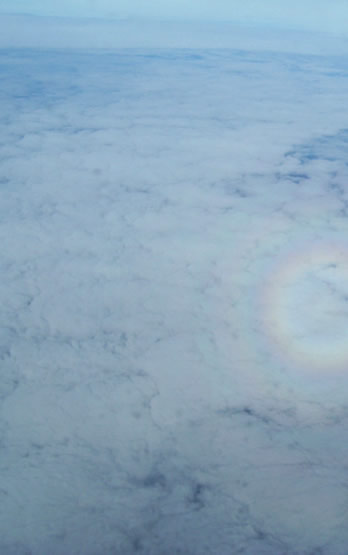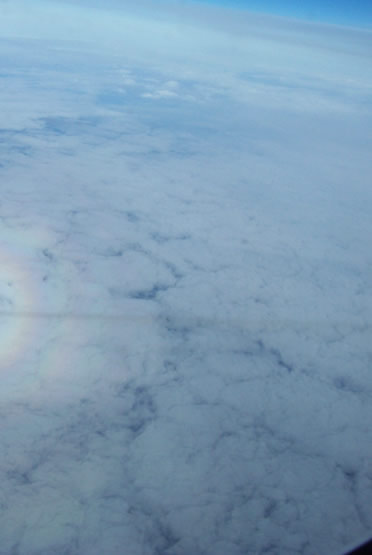|
Glory
Imaged over Greenland by Blair Brewin of Calgary, Alberta. The
delicacy of the glory is nicely captured. ©Blair Brewin, shown
with permission.
The airplane thunders onwards and from the cloud deck far below it
sparkle and shimmer the many coloured rings of a glory. The rings
march across the clouds with the aircraft
and accompanied by the comet-like tail of a contrail shadow. As
the cloud landscape slowly shifts and changes the rings alternately
shrink and swell.
A glory is one of several
optical effects at the antisolar point, the point directly
opposite the sun and therefore below the horizon in daylight.
Shadows also converge there
and when an airplane is fairly low its shadow (or rather your shadow
if you could see it) is at the glory's centre. Here
the aircraft was at cruising altitude and too high for its shadow to
show but you can see the long shadow of the contrail.
The tiny water drops of the clouds make the series of concentric rings
by backscattering
sunlight. The droplets are sufficiently
small that light waves scattered via different paths - within the
same droplet - interfere.
The interference can be constructive (producing light) or destructive (darkness).
The overall result is a circular diffraction pattern. Longer wavelengths
have larger patterns and the overlap of all the different coloured
glories from sunlight produce the complex hued rings that we see.
The glory colour production process is quite
different from that forming rainbows or
the colours of ice
halos. In those
refraction rather
than diffraction causes light
rays of different colours to take different paths through the raindrop
or ice crystal. Rainbows and ice halos are made by comparatively
large objects in the
sky, large that is compared to the wavelength of light. Glories,
coronae and iridescent clouds are made by very small cloud droplets
and sometimes, excepting glories, ice crystals.
|


